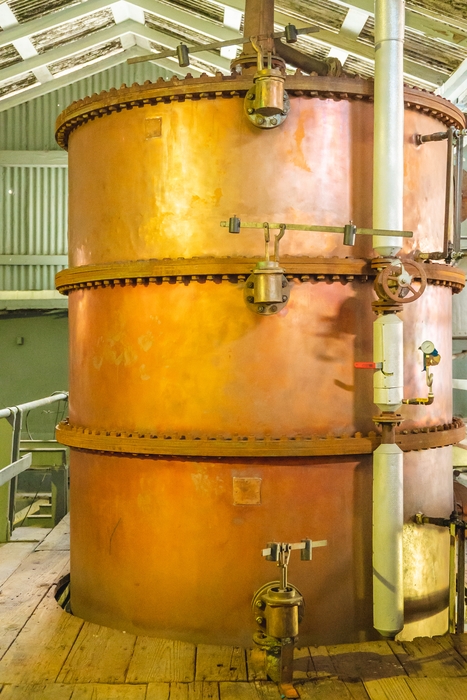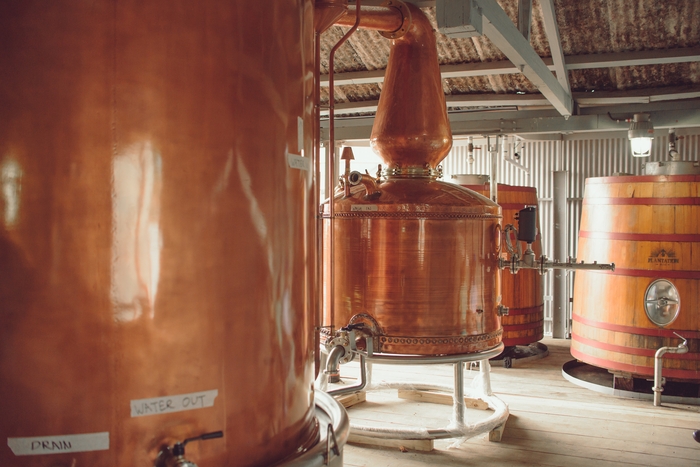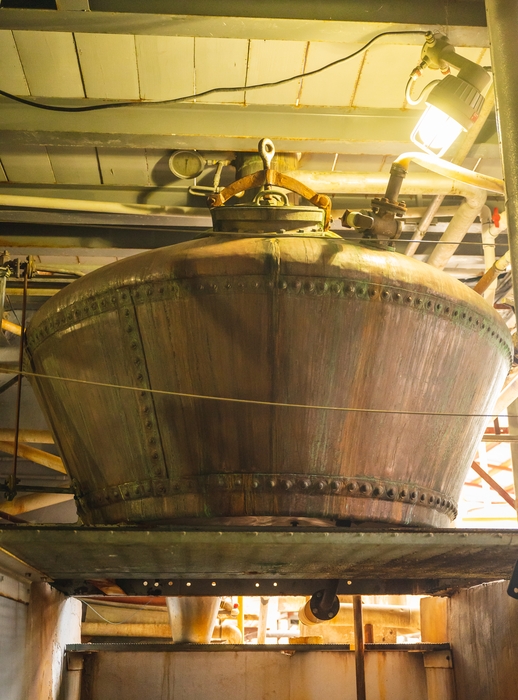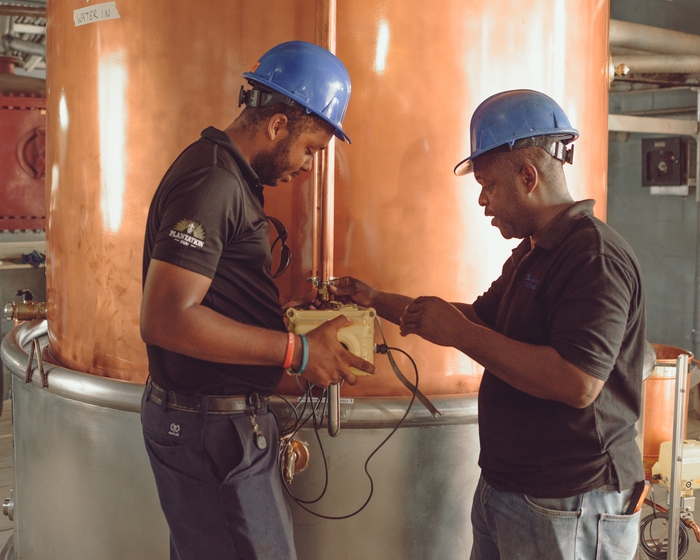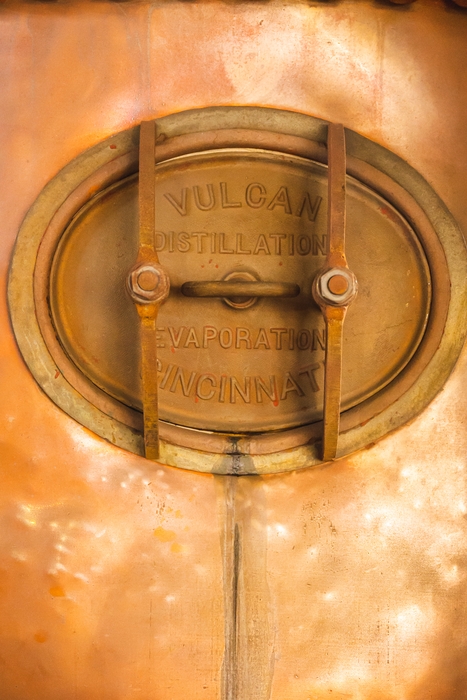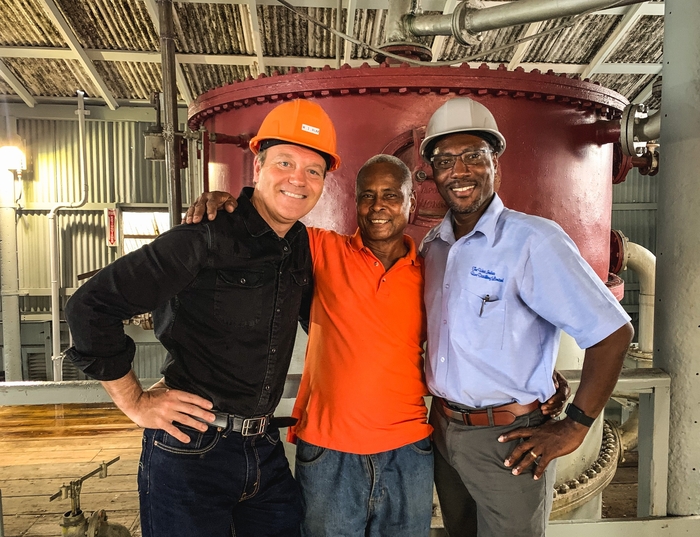
Let's continue our exploration of the West Indies Rum Distillery (WIRD) in Barbados, with the Vulcain still, which Alexandre Gabriel explains to us:
Another very interesting still from WIRD: the Vulcain. Could you tell us about it?
This is what is called a chamber still. This type of still is not at all known because it no longer existed in people's minds. I did some research with historian David Wondrich. We were quite familiar with these stills, but they are a bit like forgotten dinosaurs. David, who is American, was very proud of them. This still is to distillation what jazz is to music, that is to say "all Americana". They are also called "charge stills". It is a large tube, which instead of being a still in the style of Édouard Adam, the precursor of horizontal twists, has vertical twists, which is quite clever. The interest of horizontal twists is that they can have swan necks. So the disadvantage of the chamber still is that it cannot be equipped with one, since it feeds the chambers above, vertically.
As with the twisted stills, do we load the different chambers with distillation heads and tails?
The Vulcan is a three-chamber still, rather primitive, while the "more modern" ones have four chambers. The bottom chamber is the chamber that is filled with vinasses. There is a coil inside, where steam is injected that escapes through holes, which boils the vinasses. These vinasses have aromas. They evaporate and pass through pipes that boil the wine that is in the second chamber. The third chamber is nothing more than a wine heater. In the four-chamber configuration, there is an intermediate chamber where the wine boils a second time.
For the Vulcan, we only boil once. But we have a reflux element, which means that what comes out of the wine heater passes into a small gin still, from where the heaviest materials fall back into the wine, by reflux. Everything passes through this small still, like in a sort of twisted or thumper system. But the wine does not bubble, it is simply rectified. It is a selection element. When the distillation is finished, we close everything, we throw away the vinasses. Then we lower the vinasses from the second chamber to the first, we lower the mulled wine from the third to the second, and we start a distillation again.
"Some chamber stills were made of wood. It was really the still of the new frontier."
Even if we didn't have a boilermaker, we had a cooper and a plumber friend, and we made a still. The Vulcain is a big tube 1.50m in diameter, rather short, its disadvantage is that it is not sexy. When you see it, you say to yourself that it has not been spoiled by nature, on the other hand it has horses under the hood!
It was designed in the 19th century, we are not sure of the exact date, I would say 1880. But it was bought much later, in the United States, in the aftermath of Prohibition, when the distilleries were bled dry. At that time, the whiskey distilleries on the East Coast, in Philadelphia and Baltimore, like Pikesville for example, were almost all distilling in chamber stills. This is something that has been documented by historians like David Wondrich. They were very efficient stills, thanks to the rising heat, especially the four-chamber ones that only needed one pass. They predated the Coffey columns that replaced them for a while. But they had an aromatic signature that meant that the new column owners were confused, and bought new stills.
Then the fashion for premium whiskeys died out. Whiskey became a commodity, and while today they are back in fashion, at one time nobody cared, and that was the death of the chamber still.
So there's one left in Barbados, and another one that's a reissue. It's a three-chamber still that's at an American whiskey distiller called Leopold.
“Our friend Digger Henderson, who has been at the distillery for 43 years, knows very well how to distil with the Vulcan. And thank goodness, because there is no manual!”
There is no computer automation, everything is done with levers, one of which you have to tap with a metal bar to adjust it. They call it the Vulcan Tap, with a bar that was all rusty but which has come back into service. At the moment we distil a lot with it, including juice rums.
Precisely, does this cane juice preferentially pass through certain stills?
The juice goes through all the stills, except the big columns, since that's something that's already done in the French Caribbean. For cane juice , you have to go very quickly. We don't do fermentations like for molasses, which are super long and super sophisticated (even if we try in Jamaica). So we use the Vulcain, the Old Gregg, and the Hot Pot, which is a new still that I designed from the archives. I recovered the cucurbit from a cognac still. It's completely riveted, which was the common denominator of all the stills at the time. The head, the capital, the swan neck, etc. were taken from the drawings that we found in our archives. These three stills currently spend the whole day distilling juices.
So the Hot Pot is a recent still?
Yes, I drew it because the Old Gregg is really starting to wear out. We're at 2.5 - 3mm, and it would be a shame to throw it on the ground. What's complicated is the first heating. The elements of molasses and juices are quite sulfurous, so the copper being self-sacrificial, it gets damaged. I drew this 20 hectoliter pot still with some old friends. Gaylord remade a swan neck, an exact replica of what we had in the 19th century in Barbados. So he's the one who takes the first heatings in the face. I can tell you that it pulls on his pants, because the guys from the Caribbean can't help but acidify with dunders etc.
That's why I had planned pipes that we call "downcombers". I like the charge to go to the bottom of the still, in order to homogenize. It's a plumber's copper tube, super thin. The last time I loaded the still, I noticed that the liquid wasn't really going to the bottom. I looked at what had happened after the distillation, and in fact the acidity had eaten all the copper, in three years. So I told the guys: "we don't make 2600 in esters with the Hot Pot. It dates from the end of the 19th century, it's still in shape, but it's delicate". So we're going to build a twister that will be completely designed to work with these acidified elements. The parts in contact with the liquid will be made of stainless steel, and naturally all the gaseous parts will be completely made of copper.
When you arrived at WIRD, in the end, there was only the Old Gregg running, as far as discontinuous devices were concerned…
Exactly, the Vulcan had not been running since the early 2000s, the Hot Pot did not exist and the Rockley was a decorative element of the parking lot, which served as a roundabout! We have another still called the Batson, which is in my opinion technically the brother of the Old Gregg. It is still a part of the parking lot, because for the moment I do not have the budget to rehabilitate it. It has a nickname that is not very politically correct: the "Batson's bitch". They said it was very difficult to handle. Currently it sleeps outside. It does not damage because copper does not rust, so we will repair it one day.
When researching the Batson name, it's important to understand that like Long Pond , WIRD is a marriage of many distilleries. It was called Stade's at one time, and at the time George Stade was building his column, there was a distiller who was taking over the stills of small distilleries that were closing down. He was competing with Stade's with 100% pot still rums. In the 1930s, this distiller named Charles Batson ended up closing his distillery. It was then bought by WIRD. That's where the Batson still comes from, and I think the Rockley comes from as well.
There was another distillery called Barbados Distillers. It was on the hill next to us, and we got some spare parts from it and a section of column that is no longer in use. So the West Indies Rum Distillery is the result of at least Batson, Barbados Distillers, and this famous distillery that we don't know anything about, that WIRD took the site of at the very beginning.
“It’s a magical location for a distillery,”
because you have water (it's an estate called Spring Garden). And then you're also right on the sea, which was ideal for loading the casks onto the boats. This distillery had its own jetty, where the boats would come and load the casks, to load them onto bigger boats, at the port. There's even a document in parliament that gives the distillery an eternal right to build its own jetty. It was made of wood and collapsed. But it's not too bad because the port is a mile away, so we can load the boats ourselves.
"We also have a column called the Blair, on the Coffey system, all copper."
It was commissioned in 1941 and commissioned in 1945. It is a great column, another example of which distilled at Long Pond until the 2010s, but is totally silent today. It may never distill there again, for budgetary reasons, but also because the column was a parenthesis for Long Pond. Yet it was a great column. Two weeks ago, I was with Vivian Wisdom, to whom I just gave a taste of a 22-year-old rum that I had in my stocks.
It was installed in about 1955, and when you see it, it's like walking into an old church. It blew up at some point, it's almost functional and can be repaired. But what's the point of restoring it since I have one in the West Indies, which is all connected? I'm missing a 50cm section on a 25-shelf column, so it will be repaired one day.
We also have a small column from the 1990s, with 23 trays. It distils the lees, what remains in the tank bottoms. There is also a super John Dore built in 1970 by David Pym, just before John Dore went bankrupt. It is a four-column, completely manual, which can be managed in two columns.
"She's the one who was doing Plantation until now, but she's on mute for now."
In 1990, we had a Webster & Stone, a Canadian column that is not very interesting. It is very industrial, and we used it for customers who bought light rum. I had the rectification column changed by a super geeky boilermaker friend. This column can work alone and draw rums at the desired strength. They can also go into the three other columns for customers who want light rum. So that gives me a "single column", which is actually made up of two columns placed one on top of the other for energy reasons. It is also under vacuum, which saves 30% energy.
And then what is important, when we are in a vacuum, is that we distill at a slightly lower fire point. This avoids "scaling" (the accumulation of calcifications on the plates, editor's note). We do not have to hit with a hammer and chisel to remove what has stuck on the plates. Without this, we are forced to do a "descaling" every three months, and it is really painful. We could do it every four or five months, but we would lose a lot of efficiency because the plates lose precision, they are completely scaled. With vacuum distillation, we distill at a slightly lower temperature. As in cooking, if we reduce the heat it does not stick to the bottom of the pan.
“This big investment allowed me to have a column with interesting and precise draw points.”
The old one was not thrown away, it stayed there, as is the Barbadian philosophy. I wanted to take it apart and scrap it, but the Barbadians looked at me and told me that you never do that, whether it's with columns or old air conditioning units. In the distilleries, there are only engineers, and they keep all the spare parts, "it can always be useful".
All this equipment makes you want to see it in real life; is the spirit tourism part something that interests you?
Absolutely, the distillery is at the bottom of the beach, and there was a sort of club, which was rented out to people who were setting up a bar for example. We are restoring it to make a visitor center on the waterfront, with a door that opens into the distillery itself.
We're not really the ideal distillery to visit, compared to the newer ones that are designed around that. Ours wasn't designed for that, it was the secret distillery. We did Mount Gay up until 6 years ago, as well as a lot of other brands. It was the "dark kitchen" of Barbados, so it was very secret, and not open to visitors. Among Barbadians, apart from those who were good at science at school, and knew that one of the jobs was to be a distiller in the West Indies, no one knew about it.
Don Benn (the master distiller) is a great example. He had the highest grades in his science class in this country of 150,000 people. Barbados paid him a scholarship to England. He studied engineering there, and came back to work at WIRD. Dario Jordan (the "J" in JAWS), is a university professor of yeast and fermentation . He came on sabbatical and never left. Terry Allen (the "A" in JAWS), was a brewer for Banks beer, and was keen to come and work with us on fermentation. These are the West Indies geeks.
Finally, do you have any interesting things coming up this year?
You know we have things coming up all the time. We're always working on a lot of things at once. I've been working in Paraguay for several years, on the "caña paraguaya", dehydrated juice distillates with columns of about twenty trays. They have endemic canes, as well as a wood called incienso. Their own foudriers that have been there for three generations. So there's going to be a Paraguay expression in the coming years, but also an expression from Mauritius, with old batches that are aging.
I don't know exactly when it will happen, but I've been working on a Navy rum for several years, and I'm writing a book with Matt Pietrek . I have to finish writing it. It's a bit like when I wrote a book on Grande Champagne. People said to me "but that's stupid, we know what Grande Champagne is!", so I said okay, but other than the fact that it's a cognac vintage, what do we know about it? Why is it called Grande Champagne? Since when? Who thought that this vintage was superior enough to call it "premier cru"? It's a shame not to answer all these questions, so I wrote a book on the subject, where we elucidated most of these questions.
“It’s the same thing with Navy Rum: what is Navy Rum ?”
A strong rum, yes, but to what degree? Has it changed in history? What is its origin? Who started making it? Has the blend changed? When Matt Pietrek retired from Microsoft and decided to devote himself to rum, I sponsored his research on Navy Rum. He wrote the first part thanks in part to some crazy archives that he managed to find. I bought them from this old man who had saved them from E&DF Man. It's a crazy story!
When Matt was at the National Library in England, an archivist advised him to go and meet this old gentleman, Michael Fogg. He had worked at E&DF Man, now a molasses broker, which supplied the English crown with rum for a century and a half. Mr Fogg came to the company at a time when it was no longer making rum, but rather whisky. But he wanted to keep the documents concerning rum. He kept 1m3 of the documents that seemed most valuable to him. When he met him, Matt called me and said he had all the contracts for a century, it was crazy.
“We are going to make a very limited edition of Navy Rum, with aging in open tanks, like on the docks.”
And so my part of the book will be to give the validity of all these technical elements. It will explain why our rum will be made in this way, by drawing inspiration from these different things. This is good because I have 19th century vats, practically the same size as in the docks. They are in a cellar in Javrezac, not on the banks of the Thames, but of the Antenne, a very humid floodable place. We are going to make this rum that we will call Mr Fogg, in homage to Michael Fogg who has since passed away, knowing that there would be a room in the Château de Roissac with all his archives, and a rum that will bear his name.
Thank you very much Alexandre for sharing all these adventures!
All illustrations are (c) Maison Ferrand / West Indies Rum Distillery
